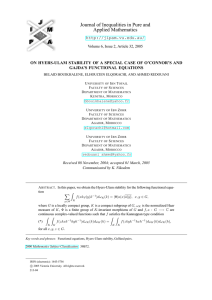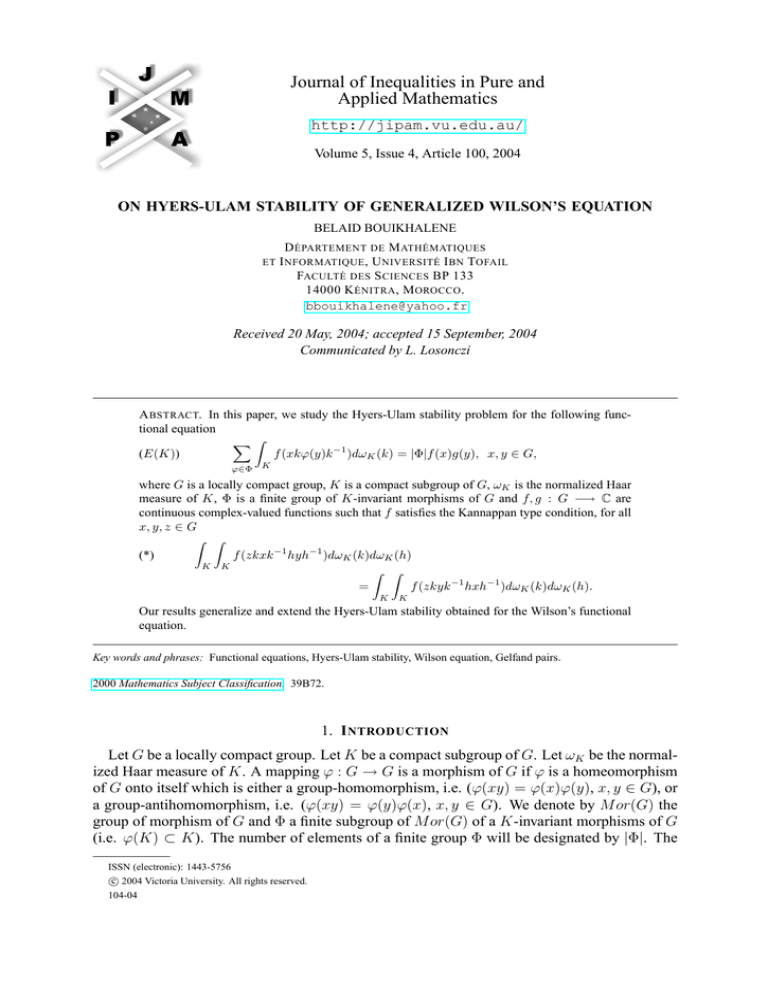
Journal of Inequalities in Pure and
Applied Mathematics
http://jipam.vu.edu.au/
Volume 5, Issue 4, Article 100, 2004
ON HYERS-ULAM STABILITY OF GENERALIZED WILSON’S EQUATION
BELAID BOUIKHALENE
D ÉPARTEMENT DE M ATHÉMATIQUES
ET I NFORMATIQUE , U NIVERSITÉ I BN T OFAIL
FACULTÉ DES S CIENCES BP 133
14000 K ÉNITRA , M OROCCO .
bbouikhalene@yahoo.fr
Received 20 May, 2004; accepted 15 September, 2004
Communicated by L. Losonczi
A BSTRACT. In this paper, we study the Hyers-Ulam stability problem for the following functional equation
XZ
(E(K))
f (xkϕ(y)k −1 )dωK (k) = |Φ|f (x)g(y), x, y ∈ G,
ϕ∈Φ
K
where G is a locally compact group, K is a compact subgroup of G, ωK is the normalized Haar
measure of K, Φ is a finite group of K-invariant morphisms of G and f, g : G −→ C are
continuous complex-valued functions such that f satisfies the Kannappan type condition, for all
x, y, z ∈ G
Z Z
(*)
f (zkxk −1 hyh−1 )dωK (k)dωK (h)
K K
Z Z
=
f (zkyk −1 hxh−1 )dωK (k)dωK (h).
K
K
Our results generalize and extend the Hyers-Ulam stability obtained for the Wilson’s functional
equation.
Key words and phrases: Functional equations, Hyers-Ulam stability, Wilson equation, Gelfand pairs.
2000 Mathematics Subject Classification. 39B72.
1. I NTRODUCTION
Let G be a locally compact group. Let K be a compact subgroup of G. Let ωK be the normalized Haar measure of K. A mapping ϕ : G → G is a morphism of G if ϕ is a homeomorphism
of G onto itself which is either a group-homomorphism, i.e. (ϕ(xy) = ϕ(x)ϕ(y), x, y ∈ G), or
a group-antihomomorphism, i.e. (ϕ(xy) = ϕ(y)ϕ(x), x, y ∈ G). We denote by M or(G) the
group of morphism of G and Φ a finite subgroup of M or(G) of a K-invariant morphisms of G
(i.e. ϕ(K) ⊂ K). The number of elements of a finite group Φ will be designated by |Φ|. The
ISSN (electronic): 1443-5756
c 2004 Victoria University. All rights reserved.
104-04
2
B ELAID B OUIKHALENE
Banach algebra of bounded measures on G with complex values is denoted by M (G) and the
Banach space of all complex measurable and essentially bounded functions on G by L∞ (G).
C(G) designates the Banach space of all continuous complex valued functions on G.
In this paper we are going to generalize the results obtained in [1], [4] and [6] for the integral
equation
XZ
(1.1)
f (xkϕ(y)k −1 )dωK (k) = |Φ|f (x)g(y),
x, y ∈ G.
ϕ∈Φ
K
This equation may be considered as a common generalization of functional equations of Cauchy
and Wilson type
x, y ∈ G,
(1.2)
f (xy) = f (x)g(y),
(1.3)
f (xy) + f (xσ(y)) = 2f (x)g(y),
x, y ∈ G,
where σ is an involution of G. It is also a generalization of the equations
Z
(1.4)
f (xkyk −1 )dωK (k) = f (x)g(y),
x, y ∈ G,
K
Z
Z
−1
f (xkyk )dωK (k) +
(1.5)
K
f (xkσ(y)k −1 )dωK (k) = 2f (x)g(y),
x, y ∈ G,
K
Z
f (xky)χ(k)dωK (k) = f (x)g(y),
(1.6)
x, y ∈ G,
K
Z
Z
f (xky)χ(k)dωK (k) +
(1.7)
f (xkσ(y))χ(k)dωK (k) = 2f (x)g(y),
K
x, y ∈ G,
K
Z
f (xky)dωK (k) = f (x)g(y),
(1.8)
x, y ∈ G,
K
and
Z
Z
f (xky)dωK (k) +
(1.9)
K
f (xkσ(y))dωK (k) = 2f (x)g(y),
x, y ∈ G.
K
If G is a compact group, the equation (1.1) may be considered as a generalization of the equations
Z
(1.10)
f (xtyt−1 )dt = f (x)g(y),
x, y ∈ G,
G
Z
Z
−1
f (xtyt )dt +
(1.11)
G
f (xtσ(y)t−1 )dt = 2f (x)g(y),
x, y ∈ G,
G
and
(1.12)
XZ
ϕ∈Φ
f (xtϕ(y)t−1 )dt = |Φ|f (x)g(y),
x, y ∈ G.
G
Furthermore the following equations are also a particular case of (1.1).
X
(1.13)
f (xϕ(y)) = |Φ|f (x)g(y),
x, y ∈ G,
ϕ∈Φ
J. Inequal. Pure and Appl. Math., 5(4) Art. 100, 2004
http://jipam.vu.edu.au/
O N H YERS -U LAM S TABILITY OF G ENERALIZED W ILSON ’ S E QUATION
XZ
(1.14)
ϕ∈Φ
f (xkϕ(y))dωK (k) = |Φ|f (x)g(y),
3
x, y ∈ G,
K
and
XZ
(1.15)
ϕ∈Φ
f (xkϕ(y))χ(k)dωK (k) = |Φ|f (x)g(y),
x, y ∈ G,
K
where χ is a unitary character of K.
In the next section, we note some results for later use.
2. G ENERAL P ROPERTIES
In what follows, we study general properties. Let G, K and Φ given as above
Proposition 2.1 ([4]). For an arbitrary fixed τ ∈ Φ, the mapping
Φ −→ Φ
ϕ 7→ ϕ ◦ τ
is a bijection and for all x, y ∈ G, we have
XZ
XZ
−1
(2.1)
f (xkϕ(τ (y))k )dωK (k) =
f (xkψ(y)k −1 )dωK (k).
ϕ∈Φ
K
ψ∈Φ
K
Proposition 2.2. Let ϕ ∈ Φ and f ∈ C(G), then we have
i)
Z
Z
−1
f (xkϕ(hy)k )dωK (k) =
f (xkϕ(yh)k −1 )dωK (k),
K
x, y ∈ G, h ∈ K.
K
ii) If f satisfies (*), then for all a, z, y, x ∈ G, we have
Z Z
f (zhϕ(ykxk −1 )h−1 )dωK (h)dωK (k)
K K
Z Z
f (zhϕ(xkyk −1 )h−1 )dωK (h)dωK (k).
=
K
K
and
Z Z Z
K
K
−1
f (ahϕ(zk1 yk1−1 h1 xh−1
1 )h )dωK (h)dωK (k1 )dωK (h1 )
K
Z Z Z
−1
f (ahϕ(zk1 xk1−1 h1 yh−1
=
1 )h )dωK (h)dωK (k1 )dωK (h1 ).
K
K
K
Proof. By easy computations.
3. T HE M AIN R ESULTS
The main result is the following theorem.
Theorem 3.1. Let δ > 0 and let (f, g) ∈C(G) such that f satisfies the condition (*) and the
functional inequality
X Z
f (xkϕ(y)k −1 )dωK (k) − |Φ|f (x)g(y) ≤ δ,
x, y ∈ G.
(3.1)
K
ϕ∈Φ
Then
J. Inequal. Pure and Appl. Math., 5(4) Art. 100, 2004
http://jipam.vu.edu.au/
4
B ELAID B OUIKHALENE
i) f , g are bounded or
ii) f is unbounded and g satisfies the equation
XZ
(3.2)
g(xkϕ(y)k −1 )dωK (k) = |Φ|g(x)g(y),
ϕ∈Φ
x, y ∈ G.
K
iii) g is unbounded, f satisfies the equation (1.1). Furthermore if f 6= 0, then g is a solution
of (3.2).
Proof. Let (f, g) be a solution of the inequality (3.1), such that f is unbounded and satisfies the
condition (*), then for all x, y, z ∈ G, we get by using Propositions 2.1 and 2.2
X Z
−1
|Φ||f (z)| g(xkϕ(y)k )dωK (k) − |Φ|g(x)g(y)
ϕ∈Φ K
X Z
|Φ|f (z)g(xkϕ(y)k −1 )dωK (k) − |Φ|2 f (z)g(x)g(y)
=
ϕ∈Φ K
X Z X Z
≤
f (zhψ(xkϕ(y)k −1 )h−1 )dωK (h)dωK (k)
ϕ∈Φ K ψ∈Φ K
XZ
g(xkϕ(y)k −1 )dωK (k)
− |Φ|f (z)
ϕ∈Φ K
X Z X Z
f (zhψ(xkϕ(y)k −1 )h−1 )dωK (h)dωK (k)
+
ψ∈Φ K ϕ∈Φ K
XZ
−1
f (zkψ(x)k )dωK (k)
− |Φ|g(y)
ψ∈Φ K
X Z
+ |Φ||g(y)| f (zhψ(x)h−1 )dωK (h) − |Φ|f (z)g(x)
ψ∈Φ K
X Z X Z
−1 −1
−1 ≤
f (zhψ(xkϕ(y)k )h )dωK (h) − |Φ|f (z)g(xkϕ(y)k ) dωK (k)
ϕ∈Φ K ψ∈Φ K
X Z X Z
+
f (zhψ(x)h−1 kτ (y)k −1 ))dωK (k) − |Φ|g(y)f (zhψ(x)h−1 ) dωK (h)
ψ∈Φ K τ ∈Φ K
X Z
−1
f (zkψ(x)k )dωK (k) − |Φ|f (z)g(x)
+ |Φ||g(y)| K
ψ∈Φ
≤ 2|Φ|δ + |Φ||g(y)|δ.
Since f is unbounded it follows that g is a solution of the functional equation (3.2). For the
second case let (f, g) be a solution of the inequality (3.1) such that f satisfies the condition (*)
and g is unbounded then for all x, y, z ∈ G, one has
X Z
−1
f (xkϕ(y)k )dωK (k) − |Φ|f (x)g(y)
|Φ||g(z)| K
ϕ∈Φ
J. Inequal. Pure and Appl. Math., 5(4) Art. 100, 2004
http://jipam.vu.edu.au/
O N H YERS -U LAM S TABILITY OF G ENERALIZED W ILSON ’ S E QUATION
5
X Z
−1
2
|Φ|g(z)f (xkϕ(y)k )dωK (k) − |Φ| g(z)f (x)g(y)
=
ϕ∈Φ K
X Z X Z
≤
f (xhϕ(y)h−1 kψ(z)k −1 )dωK (h)dωK (k)
ψ∈Φ K ϕ∈Φ K
XZ
−|Φ|g(z)
f (xkϕ(y)k −1 )dωK (k)
ϕ∈Φ K
X Z X Z
+
f (xhψ(z)h−1 kϕ(y)k −1 )dωK (h)dωK (k)
ϕ∈Φ K ψ∈Φ K
XZ
− |Φ|g(y)
f (xkψ(z)k −1 )dωK (k)
ψ∈Φ K
X Z
−1
+ |Φ||g(y)| f (xkψ(z)k )dωK (k) − |Φ|f (x)g(z)
ψ∈Φ K
X Z X Z
f (xkϕ(y)k −1 hψ(z)h−1 )dωK (h) − |Φ|g(z)f (xkϕ(y)k −1 ) dωK (k)
≤
ϕ∈Φ K ψ∈Φ K
X Z X Z
−1
−1
−1 f (xkψ(z)k hϕ(y)h ))dωK (h) − |Φ|g(y)f (xkψ(z)k ) dωK (k)
+
ψ∈Φ K ϕ∈Φ K
X Z
f xkψ(z)k −1 dωK (k) − |Φ|f (x)g(z)
+ |Φ||g(y)| K
ψ∈Φ
≤ 2|Φ|δ + |Φ||g(y)|δ.
Since g is unbounded it follows that f is a solution of (1.1). Now let f 6= 0, then there exists
δ
a ∈ G such that f (a) 6= 0. Let η = |f (a)|
and let
XZ
1
F (x) =
f (akϕ(x)k −1 )dωK (k).
|Φ||f (a)| ϕ∈Φ K
By using Proposition 2.2 it follows that F satisfies the condition (*), and by using the inequalη
ity (3.1) one has |F (x) − g(x)| ≤ |Φ|
, since g is unbounded it follows that F is unbounded.
Furthermore for all x, y ∈ G we have
X Z
−1
F
(xkϕ(y)k
)dω
(k)
−
|Φ|F
(x)g(y)
K
ϕ∈Φ K
Z
X Z
1
=
Σψ∈Φ
f (ahψ(xkϕ(y)k −1 )h−1 )dωK (h)dωK (k)
|Φ|f (a) ϕ∈Φ K
K
XZ
1
−1
− |Φ|
f (akϕ(x)k )dωK (k)g(y)
|Φ|f (a) ϕ∈Φ K
J. Inequal. Pure and Appl. Math., 5(4) Art. 100, 2004
http://jipam.vu.edu.au/
6
B ELAID B OUIKHALENE
X Z X Z
1
≤
f (ahψ(x)h−1 kτ (y)k −1 )dωK (k)
|Φ|f (a) ϕ∈Φ K τ ∈Φ K
−1
− |Φ|f (ahϕ(x)h )g(y)dωK (k)
≤ η.
From the first case it follows that g is a solution of (3.2).
Corollary 3.2. Let δ > 0 and let (f, g) ∈C(G) such that f satisfies the condition (*) and the
functional inequality
Z
Z
−1
−1
(3.3) f (xkyk )dωK (k) +
f (xkσ(y)k )dωK (k) − 2f (x)g(y) ≤ δ, x, y ∈ G,
K
K
where σ is an involution on G. Then
i) f , g are bounded or
ii) f is unbounded and g satisfies the equation
Z
Z
−1
(3.4)
g(xkyk )dωK (k) +
g(xkσ(y)k −1 )dωK (k) = 2g(x)g(y),
K
x, y ∈ G.
K
iii) g is unbounded, f satisfies the equation (1.5). Furthermore if f 6= 0, then g is a solution
of (3.4).
Remark 3.3. In the case where Φ = {I}, it is not necessary to assume that f satisfies the
condition (*) (see [1] and [6]).
4. A PPLICATIONS
The following theorems are a particular case of Theorem 3.1.
If K ⊂ Z(G), then we have
Theorem 4.1. Let δ > 0 and let f, g be a complex-valued functions on G such that f satisfies
the Kannappan condition ([12])
f (zxy) = f (zyx),
(*)
x, y ∈ G
and the functional inequality
X
f (xϕ(y)) − |Φ|f (x)g(y) ≤ δ,
(4.1)
x, y ∈ G.
ϕ∈Φ
Then
i) f , g are bounded or
ii) f is unbounded and g is a solution of the functional equation
X
(4.2)
g(xϕ(y)) = |Φ|g(x)g(y),
x, y ∈ G,
ϕ∈Φ
iii) g is unbounded and f is a solution of (1.13). Furthermore if f 6= 0 then g is a solution
of (4.2).
Corollary 4.2. Let δ > 0 and let f, g be a complex-valued functions on G such that f satisfies
the Kannappan condition
(*)
f (zxy) = f (zyx),
J. Inequal. Pure and Appl. Math., 5(4) Art. 100, 2004
x, y ∈ G
http://jipam.vu.edu.au/
O N H YERS -U LAM S TABILITY OF G ENERALIZED W ILSON ’ S E QUATION
7
and the functional inequality
|f (xy) + f (xσ(y)) − 2f (x)g(y)| ≤ δ,
(4.3)
x, y ∈ G,
where σ is an involution on G. Then
i) f , g are bounded or
ii) f is unbounded and g is a solution of the functional equation
g(xy) + g(xσ(y)) = 2g(x)g(y),
(4.4)
x, y ∈ G,
iii) g is unbounded and f is a solution of (1.3). Furthermore if f 6= 0 then g is a solution of
(4.4).
Remark 4.3. If G is abelian, then the condition (*) holds.
If f (kxh) = χ(k)f (x)χ(h), k, h ∈ K and x ∈ G, where χ is a character of K ([13]), then
we have
Theorem 4.4. Let δ > 0 and let (f, g) ∈C(G) such that f (kxh) = χ(k)f (x)χ(h), k, h ∈ K,
x ∈ G,
Z Z
Z Z
f (zkxhy)χ(k)χ(h)dωK (k)dωK (h) =
f (zkyhx)χ(k)χ(h)dωK (k)dωK (h)
(*)
K
K
K
K
and
X Z
f (xkϕ(y))χ(k)dωK (k) − |Φ|f (x)g(y) ≤ δ,
K
(4.5)
x, y ∈ G.
ϕ∈Φ
Then
i) f , g are bounded or
ii) f is unbounded and g is a solution of the functional equation
XZ
x, y ∈ G,
(4.6)
f (xkϕ(y))χ(k)dωK (k) = |Φ|f (x)f (y),
ϕ∈Φ
K
iii) g is unbounded and f is a solution of (1.15). Furthermore if f 6= 0 then g is a solution
of (4.6).
Corollary 4.5. Let δ > 0 and let (f, g) ∈ C(G) such that f (kxh) = χ(k)f (x)χ(h), k, h ∈ K,
x ∈ G,
Z Z
Z Z
(*)
f (zkxhy)χ(k)χ(h)dωK (k)dωK (h) =
f (zkyhx)χ(k)χ(h)dωK (k)dωK (h)
K
K
K
K
and
Z
Z
(4.7) f (xky)χ(k)dωK (k) +
f (xkσ(y))χ(k)dωK (k) − 2f (x)g(y) ≤ δ,
K
x, y ∈ G.
K
where σ is an involution of G. Then
i) f , g are bounded or
ii) f is unbounded and g is a solution of the functional equation
Z
Z
(4.8)
g(xky)χ(k)dωK (k) +
g(xkσ(y))χ(k)dωK (k) = 2g(x)g(y),
K
x, y ∈ G.
K
iii) g is unbounded and f is a solution of (1.7). Furthermore if f 6= 0 then g is a solution of
(4.8).
J. Inequal. Pure and Appl. Math., 5(4) Art. 100, 2004
http://jipam.vu.edu.au/
8
B ELAID B OUIKHALENE
Remark 4.6. If the algebra χωK ? M (G) ? χωK is commutative then the condition (*) holds
[4].
In the next theorem we assume that f to be bi-K-invariant (i.e. f (hxk) = f (x), h, k ∈
K, x ∈ G ([7], [10]), then we have
Theorem 4.7. Let δ > 0 and let (f, g) ∈ C(G) such that f (kxh) = f (x), k, h ∈ K, x ∈ G,
Z Z
Z Z
(*)
f (zkxhy)dωK (k)dωK (h) =
f (zkyhx)dωK (k)dωK (h),
x, y, z ∈ G
K
K
K
K
and
X Z
f (xkϕ(y))dωK (k) − |Φ|f (x)g(y) ≤ δ,
K
(4.9)
x, y ∈ G.
ϕ∈Φ
Then
i) f , g are bounded or
ii) f is unbounded and g is a solution of the functional equation
XZ
(4.10)
f (xkϕ(y))dωK (k) = |Φ|f (x)f (y),
x, y ∈ G,
ϕ∈Φ
K
iii) g is unbounded and f is a solution of (1.14). Furthermore if f 6= 0 then g is a solution
of (4.10).
Corollary 4.8 ([6]). Let δ > 0 and let (f, g) ∈ C(G) such that f (kxh) = f (x), k, h ∈ K,
x ∈ G,
Z Z
Z Z
f (zkyhx)dωK (k)dωK (h),
x, y, z ∈ G
f (zkxhy)dωK (k)dωK (h) =
(*)
K
K
K
K
and
(4.11)
Z
Z
f (xky)dωK (k) +
f (xkσ(y))dωK (k) − 2f (x)g(y) ≤ δ,
K
x, y ∈ G.
K
where σ is an involution of G. Then
i) f , g are bounded or
ii) f is unbounded and g is a solution of the functional equation
Z
Z
(4.12)
g(xky)dωK (k) +
g(xkσ(y))dωK (k) = 2g(x)g(y),
K
x, y ∈ G.
K
iii) g is unbounded and f is a solution of (1.9). Furthermore if f 6= 0 then g is a solution of
(4.12).
Remark 4.9. If the algebra ωK ? M (G) ? ωK is commutative then the condition (*) holds [4].
In the next corollary, we assume that G = K is a compact group
Theorem 4.10. Let δ > 0 and let (f, g) be complex measurable and essentially bounded functions on G such that f is a central function and (f, g) satisfy the inequality
X Z
−1
f (xtϕ(y)t )dt − |Φ|f (x)g(y) ≤ δ,
x, y ∈ G.
(4.13)
G
ϕ∈Φ
Then
i) f and g are bounded or
J. Inequal. Pure and Appl. Math., 5(4) Art. 100, 2004
http://jipam.vu.edu.au/
O N H YERS -U LAM S TABILITY OF G ENERALIZED W ILSON ’ S E QUATION
9
ii) f is unbounded and g is a solution of the functional equation
XZ
(4.14)
g(xtϕ(y)t−1 )dt = |Φ|g(x)g(y),
x, y ∈ G.
ϕ∈Φ
G
iii) g is unbounded and f ≡ 0.
Proof. Let (f, g) ∈ L∞ (G). Since f is central [5], then it satisfies the condition (*) ([4]). For
(iii), if f 6= 0 then g is a solution of the functional equation (4.14). In view of the proposition
in [9] we get the fact that g is continuous. Since G is compact then g is bounded.
R EFERENCES
[1] R. BADORA, On Hyers-Ulam stability of Wilson’s functional equation, Aequations Math., 60
(2000), 211–218.
[2] J. BAKER, J. LAWRENCE AND F. ZORZITTO, The stability of the equation f (x+y) = f (x)f (y),
Proc. Amer. Math. Soc., 74 (1979), 242–246.
[3] J. BAKER, The stability of the cosine equation, Proc. Amer. Math. Soc., 80(3) (1980), 411–416.
[4] B. BOUIKHALENE, On the stability of a class of functional equations, J. Inequal. in Pure & Appl.
Math., 4(5) (2003), Article 104. [ONLINE http://jipam.vu.edu.au/article.php?sid=345]
[5] J.L. CLERC, Les représentations des groupes compacts, Analyse Harmoniques, les Cours CIMPA,
Université de Nancy I, 1980.
[6] E. ELQORACHI AND M. AKKOUCHI, On Hyers-Ulam stability of Cauchy and Wilson equations,
Georgian Math. J., 11(1) (2004), 69–82.
[7] J. FARAUT, Analyse Harmonique sur les Paires de Guelfand et les Espaces Hyperboliques, les
Cours CIMPA, Université de Nancy I, 1980.
[8] W. FORG-ROB AND J. SCHWAIGER, The stability of some functional equations for generalized
hyperbolic functions and for the generalized hyperbolic functions and for the generalized cosine
equation, Results in Math., 26 (1994), 247–280.
[9] Z. GAJDA, On functional equations associated with characters of unitary representations of groups,
Aequationes Math., 44 (1992), 109–121.
[10] S. HELGASON, Groups and Geometric Analysis, Academic Press, New York-London 1984.
[11] E. HEWITT AND K.A. ROSS, Abstract Harmonic Analysis, Vol. I and II. Springer-Verlag, BerlinGottingen-Heidelberg, 1963.
[12] Pl. KANNAPPAN, The functional equation f (xy) + f (xy −1 ) = 2f (x)f (y), for groups, Proc.
Amer. Math. Soc., 19 (1968), 69–74.
[13] R. TAKAHASHI, SL(2, R), Analyse Harmoniques, les Cours CIMPA, Université de Nancy I,
1980.
J. Inequal. Pure and Appl. Math., 5(4) Art. 100, 2004
http://jipam.vu.edu.au/


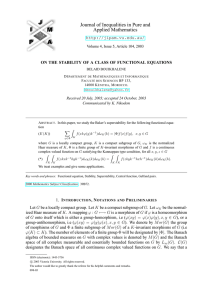

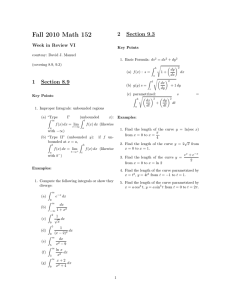
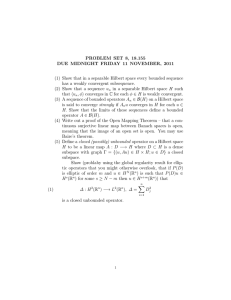
![[#JAXB-300] A property annotated w/ @XmlMixed generates a](http://s3.studylib.net/store/data/007621342_2-4d664df0d25d3a153ca6f405548a688f-300x300.png)

